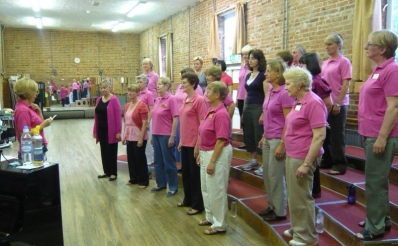Add a comment
Welwyn Well in Harmony
‹-- PreviousNext --›
I had a fun evening on Tuesday coaching Welwyn Harmony. Earlier in the year they had commissioned an arrangement from me of ‘When I Fall in Love’, and part of our agenda on Tuesday was to work on this. I never lose the thrill of the first time I hear an arrangement sung – it’s like being in two places at once to hear something that used to just exist inside my head becoming physically audible!
And of course the possibility that I might be asked to coach a group I’ve arranged for is an important force to keep me honest as an arranger. It’s so easy, when you’re sitting at home by yourself to think, ‘Well it’s a bit awkward, but I’m sure the baritones will manage it.’ But if you know you’re going to have to face them, and indeed help them round the obstacle course you’ve constructed for them, it’s a great motivation to make the effort to make the lines singable.
Indeed, we spent a lot of the evening exploring the melodic flow of the song via the bari and bass lines rather than the tune. (This might be a testament to the singability of these lines, or it might just reflect the fact that I’ve spent more time working with them while arranging – the tune didn’t need any help from me to be melodic!)
One of the principles we established at the start of the evening was the difference as well as interrelationship between my roles as arranger and as coach. While there were insights into how the music was put together that arose from having arranged it, this didn’t give me any specific rights to dictate how the song should be delivered. There was advice I could give that maybe nobody else could (though another music-focused coach would no doubt see things in there that I don’t!), but my suggestions for interpretation should be considered as advisory as any coach’s. It was my arrangement, but now it’s their song to perform.
On the other hand, anything I brought up in a technical (as opposed to artistic) dimension would be less negotiable. Stuff like breath support or vowel-matching isn’t so much a matter of individual opinion as just part of the craft of being good at doing this stuff.
In the latter dimension, we explored the interplay between rhythm, tempo, breath and articulation in the quest for a legato and in-tune delivery of an up-tempo song. They’ve been having an ongoing battle against choppiness in their delivery, especially in its middle section, and you might think that increasing the tempo might make this worse. But in fact we found that the combination of a slightly sprightlier speed and a clear, clicky pulse on 2nd and 4th (rather that 1st and 3rd) gave the song a buoyancy and lightness that made it easier to keep it all connected up.
Of course, it still needed continuity of breath: the fabric of the song was now light enough to lift, but it needs air behind it in order actually float. (My imagery here varies between kite-flying and hovercrafts – or possibly indoor sky-diving.) So, cue lots of bubbling.
Then, once the airflow was carrying the song, we could take the weight out of the consonants – the energy of the song’s rhythm and motion was all supplied by the body and breath. This freed up the muscles in the face, tongue and jaw so they didn’t need to work so hard to keep the song going.
What was interesting about this process was that as it progressed, the tuning got progressively more reliable, both in terms of the retention of tonal centre and the details of individual chords. Singing in tune is something that people do quite naturally, and if they’re not, it’s usually simply because something is getting in the way or pulling the music out of shape. Remove the obstacles and the beautiful sounds that people are hearing in their heads come straight out their mouths.












